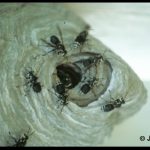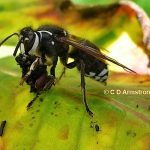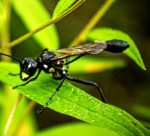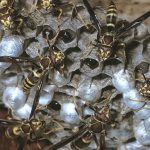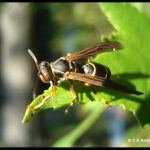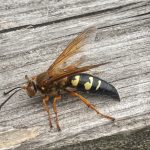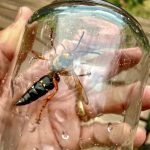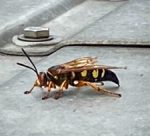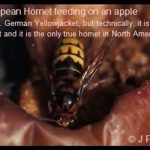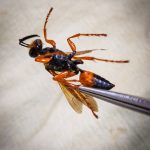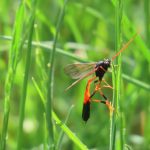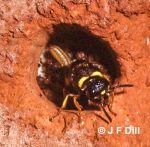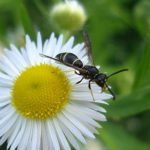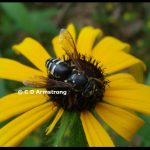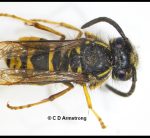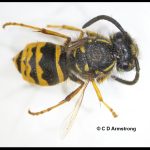Hornets, Wasps and Yellowjackets
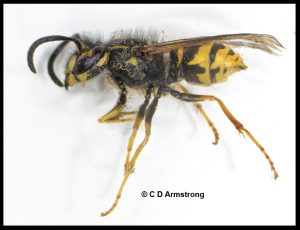
Many of Maine’s hornets, wasps and yellowjackets are members of the Vespidae family of insects. Most vespid wasps are social insects and most are capable of repeatedly stinging if they feel threatened or feel their nest is in danger. They can be a significant nuisance throughout Maine, particularly in mid to late summer when colonies reach peak numbers. The colony (nest) is started each spring by a single fertilized queen and continues to grow through the summer as more workers hatch. Hornets, wasps and yellowjackets may be aerial or ground nest builders, producing grayish paper nests in trees, shrubs, and under building eaves. They may also nest in the ground, in logs, or in the walls of structures. They prey on caterpillars and other insects, though yellowjackets will also scavenge and are often attracted to sugary and high-protein foods in garbage containers.
Family Vespidae (most are social and stinging):
- European hornets (University of Kentucky)
- Paper Wasps
- Guinea Paper Wasp (BugGuide.net)
- Northern Paper Wasp / Dark Paper Wasp – Polistes fuscatus (BugGuide.net) (also known as the Golden Paper Wasp, but not to be confused with the western species, Polistes aurifer, which is also called the Golden Paper Wasp)
- Golden Paper Wasp – Polistes aurifer (western species) (BugGuide.net)
- Potter and Mason Wasps (Solitary wasps that are capable of stinging but they are rarely aggressive) (Subfamily Eumeninae): Genus Ancistrocerus (BugGuide.net)
- Yellowjackets are small, typically yellow and black wasps, approximately 1/2-3/4 of an inch in length. They tend to be more aggressive than other wasps, will defend their colony vigorously, and can sting repeatedly. Yellowjacket species within the Vespula genus are referred to as “ground yellowjackets.”
- American / Alaska Yellowjackets – Vespula alascensis (generally nest in the ground but not always) (BugGuide.net)
- Bald-faced hornets – Dolichovespula maculata (these are technically a type of yellowjacket and are not a ‘true’ hornet). They have black and white patterns (no yellow at all) and range from 5/8-3/4 of an inch in length. They, too, are aggressive and may attack with little provocation.
- Common Aerial Yellowjackets – Dolichovespula arenaria (BugGuide.net) (they make mostly aerial nests but sometimes they’ll nest under rocks or in the ground)
- Downy Yellowjacket – Vespula flavopilosa (BugGuide.net) (thick yellow hairs on the thorax and abdomen)
- Eastern Yellowjackets – Vespula maculifrons (BugGuide.net)
- Forest Yellowjackets – Vespula acadica (BugGuide.net)
- German Yellowjackets – Vespula germanica (BugGuide.net)
- Widow Yellowjackets / Northeastern Yellowjackets – Vespula vidua (BugGuide.net)
Examples of other Families of Wasps (mostly solitary and non-stinging):
- Family Crabronidae (Square-headed Wasps, Sand Wasps, and Allies)
- Bicyrtes ventralis (BugGuide.net)
- Eastern Cicada-killer Wasp (Sphecius speciosus) (solitary) (Missouri Dept. of Conservation) See also: Eastern Cicada-killer Wasp (BugGuide.net)
- Family Ichneumonidae (Ichneumonid wasps; members are solitary and non-stinging)
- Therion circumflexum (BugGuide.net)
- Family Sphecidae (Thread-waisted wasps; most of its members are solitary):
- Gold-marked Thread-waisted Wasp (solitary) (BugGuide.net)
- Great Golden Digger Wasp (solitary) (Univ. of Wisconsin)
- Bald-faced Hornets (guarding their nest)
- Bald-faced Hornets
- Gold-marked Thread-waisted Wasp (Eremnophila aureonotata) (Rockport, ME; 8/30/2020)
- Guinea Paper Wasps (Polistes exclamans)
- Northern Paper Wasp (Polistes fuscatus) (Orono, ME; 9/14/2025) (Photo courtesy of Edward S. Grew)
- Northern Paper Wasp (Polistes fuscatus) (known also by three other common names: Dark Paper Wasp, Golden Paper Wasp and the Common Paper Wasp)
- Eastern Cicada-killer Wasp (Sphecius speciosus) (~1.5″ long; solitary and non-aggressive) (they provision their underground rearing chambers with paralyzed cicadas as food for their offspring) (Raymond Cape, ME; 7/11/2022) (Photo courtesy of Paul Tracy)
- Eastern Cicada-killer Wasp (Sphecius speciosus) (~1.5″ long; solitary and non-aggressive) (often mistaken for a Murder Hornet due to its size) (Raymond Cape, ME; 7/11/2022) (Photo courtesy of Paul Tracy)
- Eastern Cicada-killer Wasp (Sphecius speciosus) (Photo courtesy of Scott Saunders) (8/29/2021; Hollis, Maine)
- European Hornet
- Great Golden Digger Wasp (Sphex ichneumoneus) (solitary; females provision their rearing chambers or cells with katydids, one per cell with one egg deposited on each one) (Photo courtesy of Jennifer Morton; Detroit, Maine; 8/19/2021)
- A species of Ichneumonidae wasp (Therion circumflexon) (North Anson, ME; 5/23/2024) (Photo courtesy of Carol Lehto)
- Example of a Potter wasp (likely Ancistrocerus gazella) (the female collects as many as twenty caterpillars to provision each nest which she later seals with mud)
- Catskill Potter Wasp (Ancistrocerus catskill) (Troy, ME; 6/17/2008) (This wasp is a solitary species of Vespid wasp in the group known as Potter and Mason wasps.)
- A sand wasp (Bicyrtes ventralis) (Troy, Maine; 7/29/2009) Sand wasps are solitary, non-aggressive and beneficial.
- American Yellowjacket / Alaska Yellowjacket (Vespula alascensis) (female worker) (Searsport, ME; 7/23/2023)
- American Yellowjacket worker with her wings removed in order to see more of the unique abdominal patterning
- Downy Yellowjacket (Vespula flavopilosa) (Orono, ME; 9/12/2025) (Photo courtesy of Edward S. Grew)
Management:
To reduce the risk of encountering yellowjackets and other stinging wasps, remove waste frequently and maintain tight lids on trash cans. If yellowjackets are present, avoid using perfumes and wearing bright colors, and keep food and drinks covered. Commercial traps can be effective for yellowjackets but are typically not attractive to bald-faced hornets or to paper wasps. Hornet, wasp and yellowjacket nests should not be disturbed unless they pose a risk. Nuisance nests are most easily removed in early spring before the colony has had a chance to grow. Larger, well-established nests may pose enough of a risk to warrant treatment. Nests should be treated at night when the wasps are least active. Insecticide treatments should be sprayed directly into the nest entrance, whether it is above or below ground. If the nest is located inside a wall, the entrance should be located and treated but not plugged to ensure that the insecticide is carried into the nest and to avoid insects showing up inside the structure. Stings can be painful and potentially life-threatening to those with allergies. Be sure to wear protective clothing when treating and removing nests.
See also:
- Wasps and their role as a beneficial insect and pollinator (Wasps are beneficial in the environment) (Penn State Master Gardener Program)
- Controlling Wasps, Hornets and Yellowjackets (University of Kentucky) (En español: El control de avispas, avispones y avispas)

